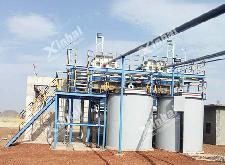

Warm Tip: If you want to know more details about equipment, solutions, etc, please click the button below for free consultation, or leave your requirements!

(Flotation machine in factory)
Froth flotation is the main beneficiation process for fluorite beneficiation. In this article, we will learn about the different types of fluorite flotation processes.
Let’s dive in!
According to the different gangue minerals, fluorite ore can be divided into four types, namely quartz fluorite ore, carbonate fluorite ore, barite fluorite ore and Sulphide fluorite ore.
(1)Quartz fluorite ore: the main minerals are fluorite and quartz, the fluorite content can reach 80% to 90%. and it contains a small amount of calcite, barite and sulfide.
(2) Carbonate fluorite ore: the main minerals are fluorite and calcite. Calcite content can reach more than 30%, with a small amount of quartz, sometimes forming a quartz-calcite fluorite ore.
(3) Barite fluorite ore: The main minerals are barite and fluorite, with a barite content of 10% to 40%. This type of ore is often accompanied by pyrite, galena, sphalerite, and other sulfides, and sometimes the quartz content increases, forming a quartz-barite and fluorite type ore.
(4) Sulphide fluorite ore: its mineral composition is basically the same as quartz-fluorite but contains more metal sulfides, sometimes lead and zinc content can reach industrial grade.
For quartz-type fluorspar ore, the main focus is on silicon reduction in the concentrate. For fine-grained embedded quartz-type fluorite ore generally use oleic acid or oxidized paraffin soap as a collector, sodium carbonate as a pulp PH conditioner, sodium silicate as an inhibitor. The stage grinding is adopted for the flotation separation process, and high-quality fluorite concentrate can be obtained after multiple selections.
For carbonate fluorite ore, since both fluorite and calcite minerals contain calcium ions and their solubility is similar, there is the mutual transformation between minerals when coexisting in solution, which makes it more difficult to separate fluorite and calcite.
Generally, sodium silicate or salted sodium silicate or acidified sodium silicate is used to inhibit carbonate, oleic acid or other fatty acid as the collectors for fluorite; in the range of PH 8 to 9.5, both calcite and fluorite can be well trapped by oleic acid, And inhibitors need to be used to adjust the difference of floatability of these two minerals, so as to achieve the separation of the two.
For fluorite ore containing more calcite, limestone, dolomite, and other more complex fluorite ore, it is better to inhibit these vein minerals with tannin extract and lignin sulfonate.
For barite fluorite ore, the separation of fluorite and barite is also a difficult part of the fluorite flotation process due to the similar floatability of barite and fluorite.
Generally, sodium carbonate is used as the conditioners, sodium silicateas as the gangue inhibitor, and oleic acid as the collectors to obtain a mixed concentrate of fluorite and barite by mixed flotation, and then the mixed concentrate is separated by flotation of fluorite and barite. There are two ways to separate fluorite and barite : one is to inhibit barite flotation of fluorite, and the other is to inhibit fluorite flotation of barite. Studies have found that trivalent cations such as Al3+, Fe3+ have an inhibitory effect on barite, while fluorite has an activating effect, and conversely, barium and lead salts of divalent can activate barite to inhibit fluorite.
The composition of sulfide ore-type fluorite ore is similar to that of quartz-type fluorite mineral, but the content of metal sulfide is higher, and sometimes the content of lead and zinc can reach industrial grade. Therefore, when developing and utilizing fluorite, we must also consider the recovery of metal ore.
For fluorite associated with sulfide ore, generally, the sulfide ore is floated with xanthate collectors first, and then fatty acid agents are added to flotation fluorite. Sometimes in fluorite flotation operations, a small amount of sulfide ore inhibitor (e.g. cyanide) is added to suppress residual sulfide to ensure the quality of the fluorite concentrate.
In addition, the roasting and leaching processes can also be used to extract valuable metals and decompose fluorspar, with relatively simple processes and the ability to prepare high-quality fluorite products while comprehensively recycling valuable metals.
The above are 4 types of froth flotation processes of fluorite ore. It is suggested to choose the suitable flotation process from the turn-key mineral processing solution provider. If you have any questions or want to know more about the flotation process, please contact us.
Last: 4 Types of Mineral Processing Test
Next: 7 Tips for Energy Saving and Consumption Reduction in Mineral Processing Plant
1How To Do Flotation Test?
 0
0
 4672
4672
24 Q&A You Need to Know About Froth Flotation Process
 0
0
 3804
3804


What Are the Differences Between CIP and CIL?
 10407
10407
 0
0